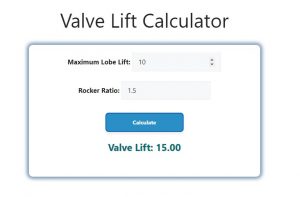About Valve Lift Calculator (Formula)
In automotive engineering, valve lift plays a crucial role in engine performance and efficiency. It refers to the distance a valve opens, allowing air and fuel to enter the combustion chamber and exhaust gases to exit. The amount of lift is determined by the camshaft lobe lift and the rocker arm ratio. Understanding how to calculate valve lift is essential for optimizing engine performance, improving fuel efficiency, and achieving desired horsepower. This article will guide you through the formula, usage, and importance of the valve lift calculator.
Formula
The formula for calculating valve lift is as follows:
Valve Lift = Camshaft Lobe Lift × Rocker Arm Ratio
Where:
- Camshaft Lobe Lift is the vertical distance the camshaft lobe moves.
- Rocker Arm Ratio is the ratio of the arm’s length from the pivot point to the point where the lift is applied.
How to Use
Using the valve lift calculator is simple. Follow these steps:
- Input the Camshaft Lobe Lift: Enter the camshaft lobe lift measurement in millimeters into the designated input field.
- Input the Rocker Arm Ratio: Enter the rocker arm ratio, which is a unitless value reflecting the length ratio of the rocker arm.
- Calculate the Valve Lift: Click the “Calculate” button to find out the valve lift. The result will be displayed in millimeters.
Example
For instance, suppose the following measurements are available:
- Camshaft Lobe Lift: 10 mm
- Rocker Arm Ratio: 1.5
Using the formula:
Valve Lift = Camshaft Lobe Lift × Rocker Arm Ratio
Valve Lift = 10 mm × 1.5
Valve Lift = 15 mm
In this example, the valve lift would be 15 mm, indicating how far the valve opens during operation.

FAQs
- What is valve lift?
Valve lift is the distance a valve opens, influencing engine airflow and performance. - Why is valve lift important?
Proper valve lift is critical for maximizing engine efficiency, power, and fuel economy. - What does the camshaft lobe lift affect?
The camshaft lobe lift directly influences the valve lift and, consequently, the engine’s performance characteristics. - What is a rocker arm ratio?
The rocker arm ratio is the ratio of the lengths of the rocker arm’s input and output sides, affecting how much lift is transferred to the valve. - How do I choose the right rocker arm ratio?
The right rocker arm ratio depends on your engine’s design and performance goals; consult with an expert or manufacturer specifications. - What happens if valve lift is too high?
Excessive valve lift can lead to valve train instability, increased wear, and potential engine damage. - Is there a standard valve lift measurement?
There is no universal standard; the appropriate valve lift varies based on engine design and intended use. - How can I measure camshaft lobe lift?
Camshaft lobe lift can be measured using a dial indicator or similar precision measuring tools. - Can valve lift be adjusted?
Yes, valve lift can often be adjusted by changing the camshaft or rocker arms. - What tools do I need for this calculation?
You only need the valve lift calculator, along with the camshaft lobe lift and rocker arm ratio values. - Can this calculator be used for different engines?
Yes, it can be used for any engine where camshaft and rocker arm specifications are available. - How does valve lift impact horsepower?
Increased valve lift generally allows for more airflow, which can enhance horsepower. - What role does the camshaft play in engine performance?
The camshaft controls the timing and duration of valve openings, significantly affecting engine efficiency. - Can I optimize valve lift for racing?
Yes, many racers adjust valve lift to maximize performance under specific racing conditions. - How often should I check my valve lift?
It’s advisable to check valve lift during regular engine maintenance or after making modifications. - Is valve lift the only factor in engine performance?
No, other factors such as timing, air-fuel mixture, and exhaust design also play significant roles. - Do different engine types require different valve lifts?
Yes, valve lift requirements can differ based on engine types, such as performance, racing, or daily driver engines. - Can this calculator help with DIY engine builds?
Absolutely! It’s a valuable tool for anyone building or modifying an engine to ensure optimal performance. - What is the relationship between valve lift and RPM?
Higher valve lifts can allow engines to achieve higher RPMs by improving airflow. - How does temperature affect valve lift?
Engine temperature can influence the materials’ behavior in the valve train, potentially affecting lift and performance.
Conclusion
The valve lift calculator is an invaluable tool for automotive enthusiasts and professionals looking to enhance engine performance. By accurately calculating valve lift using the provided formula, users can make informed decisions regarding engine modifications and optimizations. Understanding the relationship between camshaft lobe lift, rocker arm ratio, and valve lift allows for tailored performance enhancements that meet specific driving needs. Regular use of this calculator will aid in achieving the best possible performance from any engine setup.